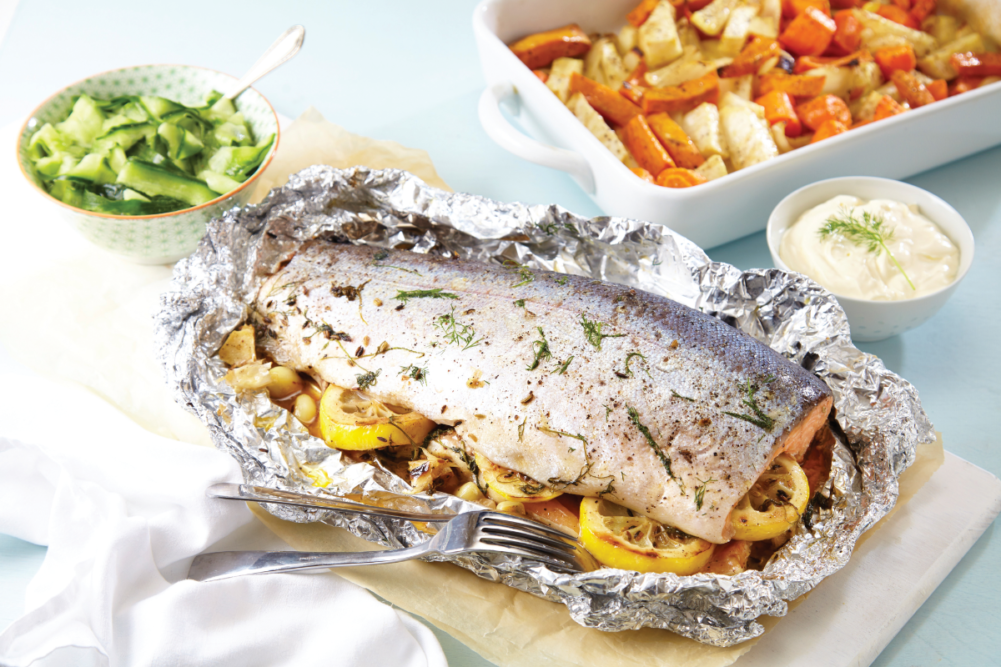Norwegian steelhead trout, uniquely raised in a combination of salt water from the sea and fresh water from the country’s fjord-fed rivers, is steadily gaining popularity in the United States, said Egil Ove Sundheim, US director for the Tromso-based Norwegian Seafood Council.
It’s still a small market. Norwegian fisheries produce about 60,000 to 80,000 metric tons of steelhead per year. That’s compared to about 1.2 metric tons of salmon.
But it is growing, Sundheim said. The salt/freshwater mix helps give Norwegian steelhead a unique value proposition in the United States market, which also contains steelhead from the United States, Canada and Chile.
Norwegian fish is characterized by a deep red color and fat marbling that delivers juicy meat and a unique mouthfeel, Sundheim said.
“The color is deeper red than salmon — it’s very pleasing to the eye,” he said. “And it’s very moist when you cook it. If you cook it a little too long, it’s very forgiving.”
That’s a good fit for Americans, who, on average, tend to worry more than people from other countries about under-cooking fish, he added.
COVID’s impact
The entire industry has felt the blow of COVID-19, said Peter Fritsch, president of Palmyra, Wisconsin-based Rushing Waters Fisheries.
“There is no way to plan or make changes fast enough when you lose all restaurant business over night,” Fritsch said. “The run on toilet paper and bread unfortunately did not include rainbow trout. We’ll wait to see what the ‘new normal’ is after we’re able to hit the streets again.”
One bright spot: Rushing Waters’ online orders have increased about 200%. Will shopping/eating habits change for good; I do believe we will see some permanent changes.
Rushing Waters is unveiling new packaging that will better communicate to the customer why they should choose the company’s product, Fritsch said.
“This rollout will be much different from others as we drill down and really focus on the basics of what powers our fish.”
Additional details of the packaging changes are imminent, he said. The changes are in line with Rushing Waters’ commitment to educating its customers about its farm and how trout on it are raised.
With other narratives emerging in the marketplace, telling that story is more important than ever, he added.
“There has been a lot of advancement in RAS (recirculating aquaculture systems) in the news and their fish are hitting the market,” Fritsch said. “These indoor RAS farms are doing a great job telling their story about being 100% contained and having low environmental discharges.”
As a result, he added, Rushing Waters is now charged with retelling its own story, complete with how aquatic weeds act as natural filters and how aquatic insects are available as snacks 24/7 to its trout.
Oh, and there’s one more important thing.
“They’re raised in nature with access to the environment — including the sun.”
Overall demand hasn’t changed much in the past year, Fritsch said.
“It seems that as many chefs add it to the menu as take it off. Our retail partners are very consistent overall, with a few promotions thrown in.”
A salmon alternative
Because of its large size, compared to other trout, and its red color, Norwegian steelhead is typically marketed as an alternative to salmon.
At Costco and Wegmans stores in the United States, for instance, the product is typically merchandised with the salmon and considered part of that category, Sundheim said. For salmon fans, it provides a slightly different flavor and mouthfeel experience.
“With many dishes, you can use salmon and steelhead interchangeably,” he said. “The salmon category has evolved. As steelhead is becoming more available, its lends itself well to fine dining, and fine dining gets access to a new species. It creates an interesting pocket in the market.”
And, of course, what starts in fine dining often works its way into other channels, like retail grocery.
Norwegian steelhead is typically marketed in US grocery stores as whole filets or portions, Sundheim said. Very little is marketed whole in traditional stores, though there is a thriving niche market in New York and other markets among Jewish communities where whole steelhead is desired for certain miles.
A growth market in the United States within the Norwegian steelhead category, Sundheim said, is sushi. Many European and Asian countries are already on the steelhead sushi bandwagon, he said.
Some US sushi restaurants are on board, too, he added, and it’s likely only a matter of time before a Hissho or another grocery instore sushi provider begins adding Norwegian steelhead product to its mix. That same marbling that makes Norwegian steelhead a forgiving fish when overcooked also lends itself to raw consumption.

